This document is a project report submitted by Nikhil D'Souza for his Master of Management Studies program. The report studies society's perceptions of electronic security surveillance (CCTV) for Zicom SaaS Pvt. Ltd. where Nikhil interned. It includes an introduction to Zicom, which is a pioneer in electronic security in India offering CCTV, access control, fire alarm, and remote managed security services. The report aims to analyze perceptions of CCTV usage and how to market CCTV security services to housing societies effectively. It covers literature reviewed, the research methodology, data analysis, findings, and recommendations.
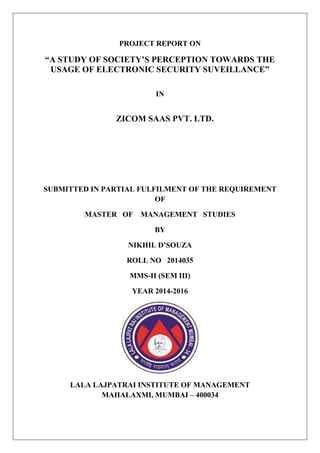








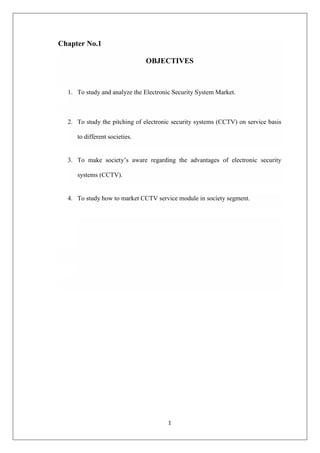



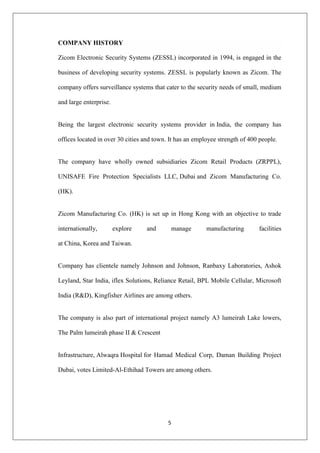


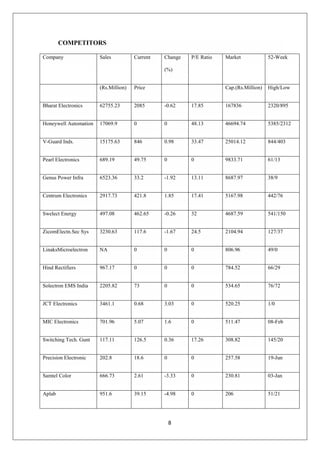
























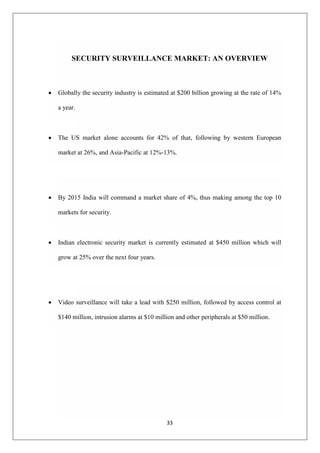



![37
Chapter No.5
DATA ANALYSIS& INTERPRETATION
1] Is electronic security systems are important in societies?
No. of Respondent
Societies Yes No
70 56 14
Above table shows:
According to survey 80% societies responded that “Yes” it is important to install
Electronic Security Systems in different societies and 14 societies responded “No”
that is because they are unaware about the crimes happening in different societies.
80%
20%
Yes No](https://image.slidesharecdn.com/70dcee07-a63e-42ad-9d78-ead201558085-170204103740/85/merged_document-46-320.jpg)
![38
2] Does CCTV affect the way you behave?
Above table shows:
According to survey 90% societies responded that “Yes” CCTV will affect the way of
behavior in society and 10% societies responded “No” that is because they are
unaware about the importance of CCTV cameras.
90%
10%
Yes No
No. of Respondent
Societies Yes No
70 63 7](https://image.slidesharecdn.com/70dcee07-a63e-42ad-9d78-ead201558085-170204103740/85/merged_document-47-320.jpg)
![39
3] Do you think CCTV controls societies and invades privacy?
Above pie diagram shows:
According to survey 80% societies responded that “Yes” CCTV can control crimes in
society and 15%societies responded “No” that it will not control because they are
unaware about the importance of CCTV cameras and 5% societies responded that
they Don‟t know.
80%
15%
5%
Yes No Don't Know
No. of Respondent
Societies Yes No Don’t Know
70 56 11 3](https://image.slidesharecdn.com/70dcee07-a63e-42ad-9d78-ead201558085-170204103740/85/merged_document-48-320.jpg)
![40
4] Does CCTV make you feel safer?
Above table shows:
According to survey 50% societies responded that “Yes” CCTV can make you safer
in the society and 40%societies responded “No” that it will not because they are
unaware about the importance of CCTV cameras in society and 10% societies
responded that it Doesn‟t effect on safety.
50%
40%
10%
Yes No Doesn't Affect
No. of Respondent
Societies Yes No Doesn’t Affect
70 35 28 7](https://image.slidesharecdn.com/70dcee07-a63e-42ad-9d78-ead201558085-170204103740/85/merged_document-49-320.jpg)
![41
5] Does CCTV affect the risk of crime?
No. of Respondent
Societies Yes No Don’t Know
70 35 28 7
Above table shows:
According to survey 50% societies responded that “Yes” CCTV will affect the risk of
crime in the society and 40%societies responded “No” that it will not because they are
unaware about the importance of CCTV cameras in society and 10% societies
responded that they Don‟t know.
50%
40%
10%
Yes No Don't Know](https://image.slidesharecdn.com/70dcee07-a63e-42ad-9d78-ead201558085-170204103740/85/merged_document-50-320.jpg)
![42
6] How do you think crime in surrounding areas is affected by
CCTV?
No. of Respondent
Societies Reduce Increase
70 49 21
Above table shows:
According to survey 70% societies responded that “Reduce” CCTV will helps to
reduce the crimes in the society and 30%societies responded “Increase” because they
are unaware about the crimes happening in society.
70%
30%
Reduce Increase](https://image.slidesharecdn.com/70dcee07-a63e-42ad-9d78-ead201558085-170204103740/85/merged_document-51-320.jpg)
![43
7] Do you think the societies would be safe without CCTV?
Above table shows:
According to survey 80% societies responded that “Yes” CCTV would make safe
people in the society and 20%societies responded “No” that it will not because they
are unaware about the importance of CCTV cameras in society.
20%
80%
Yes No
No. of Respondent
Societies Yes No
70 14 56](https://image.slidesharecdn.com/70dcee07-a63e-42ad-9d78-ead201558085-170204103740/85/merged_document-52-320.jpg)
![44
8] Does CCTV affect different crimes in different ways
No. of Respondent
Societies Yes No Neutral
70 21 6 43
Above table shows:
According to survey 30% societies responded that “Yes” CCTV will affect the
different crime‟s in different ways and 9%societies responded “No” that it will not
because they are unaware about the importance of CCTV cameras in society and 61%
societies respondents are “Neutral” that they Don‟t know.
30%
9%
61%
Yes No Neutral](https://image.slidesharecdn.com/70dcee07-a63e-42ad-9d78-ead201558085-170204103740/85/merged_document-53-320.jpg)
![45
9] How does CCTV affect society safety?
Above table shows:
According to survey 70% societies responded that “Detect crime” CCTV will detect
the crime happening in the society and 30%society‟s responded “Deters crime” that it
will not because they are unaware about the importance of CCTV cameras in society.
70%
30%
Detect Crime Deters Crime
No. of Respondent
Societies Detect crime Deters crime
70 49 21](https://image.slidesharecdn.com/70dcee07-a63e-42ad-9d78-ead201558085-170204103740/85/merged_document-54-320.jpg)
![46
10] Does CCTV affect victimization?
Above table shows:
According to survey 80% societies responded that “Yes” CCTV will affect the
victimization and 20%societies responded “No” that it will not affect the
victimization because they are unaware about the importance of CCTV cameras in
society.
80%
20%
Yes No
No. of Respondent
Societies Yes No
70 56 14](https://image.slidesharecdn.com/70dcee07-a63e-42ad-9d78-ead201558085-170204103740/85/merged_document-55-320.jpg)




![Chapter No.10
ANNEXURE
1] Is electronic security systems are important in societies?
Yes
No
2] Does CCTV affect the way you behave?
Yes
No
Don’t know
3] Do you think CCTV controls societies and invades privacy?
Yes
No
Don’t know
4] Do you think CCTV is needed in order to detect and deter crime and for
public safety?
Yes
No
Don’t know](https://image.slidesharecdn.com/70dcee07-a63e-42ad-9d78-ead201558085-170204103740/85/merged_document-60-320.jpg)
![5] Does CCTV affect the risk of crime?
Yes
No
Don’t know
6] How do you think crime surrounding areas is affected by CCTV?
Reduce
Increase
7] Do you think the societies would be safe without CCTV?
Yes
No
8] Does CCTV affect different crimes in different?
Yes
No
Neutral](https://image.slidesharecdn.com/70dcee07-a63e-42ad-9d78-ead201558085-170204103740/85/merged_document-61-320.jpg)
![9] How does CCTV affect Public Safety?
Detects Crime
Deters Crime
10] Does CCTV affect victimization?
Yes
No](https://image.slidesharecdn.com/70dcee07-a63e-42ad-9d78-ead201558085-170204103740/85/merged_document-62-320.jpg)



